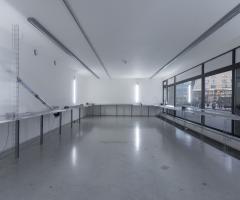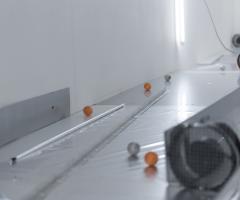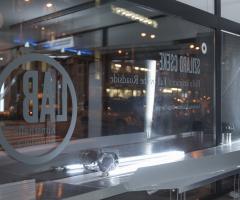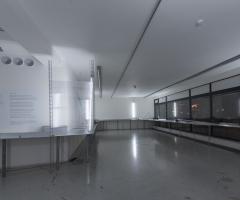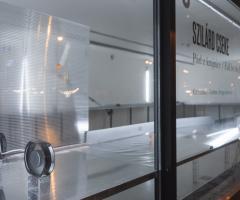SZILÁRD CSEKE: Fall by the Roadside
Kunsthalle LAB
Exhibition view // Photo © archive of KHB / Adam Šakový
Opening:
December 7th 2017
from 5 p.m. until 7 p.m.
Duration:
December 8th 2017 - February 5th 2018
Venue:
Kunsthalle LAB
„We must find meaning not simply for our complex personal interrelationships, but also for interrelationships in the global context, as we are part of the whole.”
Gerhard Johann Lischka
With the display at the Kunsthalle LAB entitled Fall by the Roadside Szilárd Cseke realised a spacious, mature installation rich in allusions. The site specific installation is a big kinetic model, a work of art which presses contemporary questions. Cseke put up the installation as a critical model for discussion and intervention.
The goal was to create a complex system, a space filled with eventful life: on a bricollage-path, white table tennis balls continuously rush on the „road”, driven by fans and turbines. The route of the balls is full of obstacles and ambushes. The spheres are occasionally directed from the plotting board into the steeply escalating transparent or even opaque tubes, while some of the spheres fall off, leaving the path. Some balls acquiring a high speed, fly straight into the windows of the exhibition space, from which they bounce back, falling back onto the designated trajectory.
Four polycarbonate plates, acting as walls, protect or obstruct the bouncing balls from falling to the ground. Meanwhile, the path paved with mirror films and lit with LED light-tubes continues: air deflector plates, wire grids refract the light and guide or obstruct the track of the balls. The „traffic” is huge, the motion and the sliding is unpredictable, with the constant danger of dropping off the path. The presence of serendipity is also there, with the visitor’s interaction, who can pick up and put back one of the fallen spheres. Onto the highways of our lives? Ascending and falling under, bouncing back and rebounding.
The installed, maquette-like, route filling up the gallery space can be understood as a symbol of life itself. A performative dimension and a process, the timely progress doesn’t end, as it is cyclic. Surrounded by the ventilators’ humming winds and loud, humdrum noise, the visitor as the observer realizes: he/she is at the center, as a human, almost god-like, or at least in a supportive position. Upon intervention, if he/she puts back the ball upon its fall into its ever-lasting cycle, he/she can relive her/his own similar moments, experiences. When in the past with a gesture, a decision, with a small movement he/she helped someone; helped someone to get back on a track, performing an interaction that was designated to him/her. According to George Simmel, „life is motion”. Complementing perpetual motion, as a significance of the wholeness of existence, good deeds are also a huge part of the process.
The Bratislavan display by Cseke Szilárd is an implication of human fate, the experiences of migrants, expats, lifestyle changers: survivors of euphoric and desperate situations. So the route-model is valid both on a communal and a personal level, like the former site-specific spatial installation entitled Sustainable Identities, at the Biennale Arte in Venezia (2015, Hungarian Pavilion). Big white balls continuously moved back and forth inside seven translucent tubes, which were stretched across the space, and they called attention to identity formations. The system of tubes above the visitors’ heads divides the space into segments. The paths could be interpreted as routes of identities, as constructed images in motion.
Szilárd Cseke „builds on a specific tradition within kinetic art which uses the poetry and dynamism of movable parts in mobiles and environments in order to create images of thought for complex social, economic or ecological processes.” (Fritz Emslander)
For decades, the artist has been creating objects which incorporate movement and which, through their materials and critical titles function as associative elements. Cseke explained in an interview: by the kinetic object Good Shepherd (2013) the goal was, to form a „critical model of contemporary social systems”. (Artguideeast, 2015/02/16)
Sociologist’s Dirk Baecker’s writing that appeared in 2007 as „Next Society” is analyzed by contemporary art theory and art practices. It seems many don’t see his artistic endeavour as a production of artistic artefacts. An artwork is not the goal of art, but its raw ingredient. This means that Cseke’s exhibition in the Kunsthalle LAB, couldn’t have been static and it couldn’t have been independent of the given space. It is simultaneously: a raw ingredient, a plotting board full of innuendos and an abstract system.
„Cseke’s installations offer the possibility to create space to contemplate and remind us that we are travellers.” (Daniela Gottschlich)
Kinga German
Exhibition curator
- - - - -
- - - - -


















